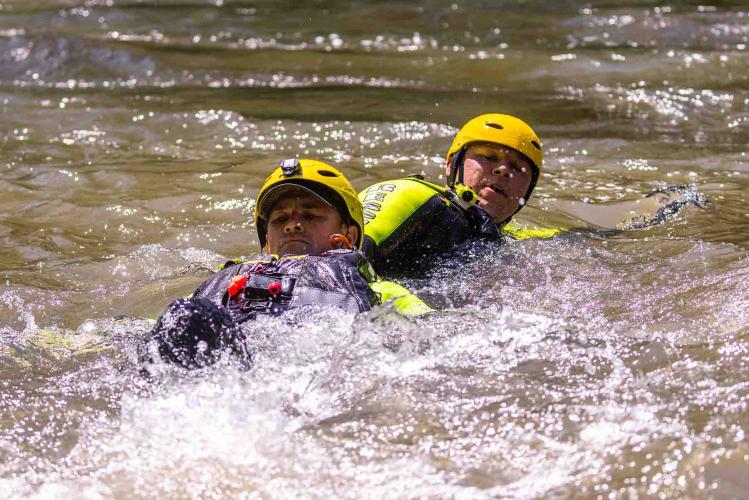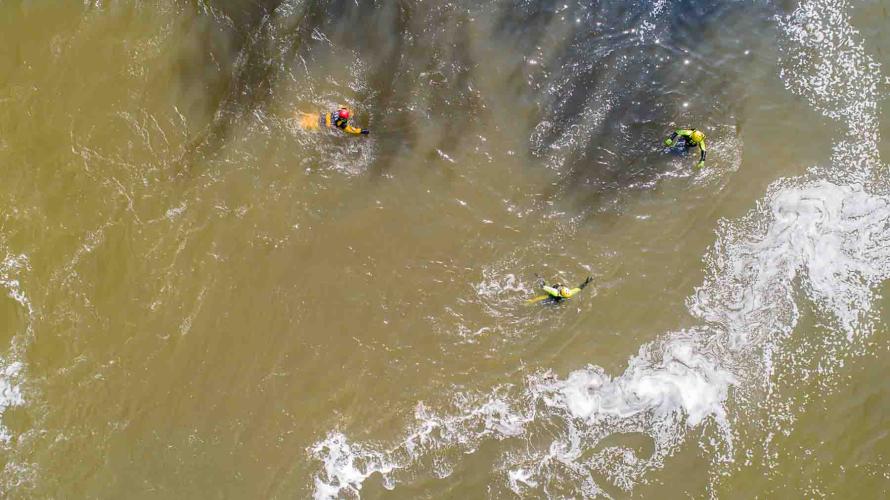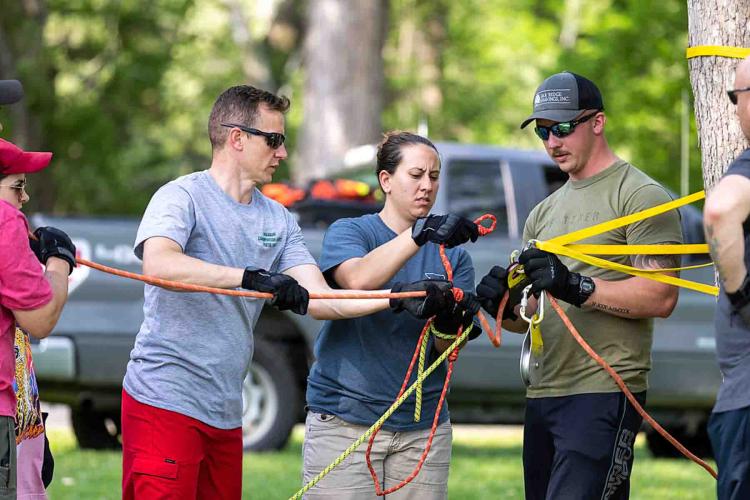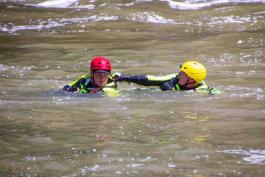
People were on top of vehicles, trapped in their cars, or stranded on shore when rescuers reached the surging floodwaters of the Little Third Fork River at sunrise on June 25, 2021. Storms had dropped 6 to 11 inches of rain on northwest Missouri overnight. A normally small and placid country stream was raging, and in pre-dawn darkness, the torrent swept unsuspecting motorists off Missouri 31 highway. Lt. Jason Braunecker, MDC protection district supervisor, was one of the first conservation agents on the scene in southwest DeKalb County, east of St. Joseph, along with sheriff’s deputies and the Missouri Highway Patrol.
They didn’t plunge in to help. Instead, they planned and prepared quickly but carefully, deciding what boat and equipment to use, and how to make approaches to victims with fast, heavy current boiling over a roadway. They observed obstacles and evaluated what the water was doing. Carry a gallon of water in a bucket and you learn water’s heavy weight. When thousands of gallons per second are rapidly flowing downhill, the force is immense, and people are helpless against that force unless they understand it.
That’s where the swift-water rescue training MDC provides to conservation agents and public safety responders makes a difference between lives lost or saved. At the Little Third Fork River, frightened people were safely plucked off car tops, helped from inside their stranded vehicles, or assisted from floodwater to safe places. Some victims had medical issues and emergencies, too.
Fast-moving water, Braunecker said, “is powerful and relentless. We understand the power of water. We didn’t beat Mother Nature. We used our training to make sure we safely saved people.”
Learning in Fast Water
In May 2022, conservation agents were joined by personnel from fire departments in Riverside and Neosho to learn rescue skills in turbulent water being released from the Pomme de Terre Lake dam at Hermitage. By swimming, using inflatable boats, or setting up cross-stream rope rescue lines they tried out techniques for various swift-water scenarios in the swollen Pomme de Terre River. Completing the course gave participants rescue certification by Dive Rescue International.
“If they’re not swift-water certified,” said Braunecker, watching agents do swim rescue training, “it’s easy to get hurt or killed.”
Some agents in wetsuits and life jackets leaped into the river’s swirling currents to practice a swimming rescue. Agents near swift water always wear life jackets.
“Water exerts a force,” Braunecker said. “People underestimate the force of the water out there, it’s very intense. The force quadruples as water velocity doubles.”
Dangerous waters can occur anywhere in Missouri, whether from floods or in naturally fast Ozark streams. Since 2018, MDC conservation agents have filed more than 230 incidents involving floods, weather, or fire. Some incidents did not result in a swift-water or flood rescue. But many did.
For example:
- On July 26, 2022, Conservation Agent Ben Pursley used a boat to help emergency crews rescue 116 people from flash flooding at an apartment complex in Hazelwood in St. Louis County.
- Conservation Agents Jade Wright, Anthony Maupin, and Eric Abbot were awarded a state Medal of Valor in 2014 for rescues they conducted in Holt County after a 9-inch rain caused flash flooding along Route N and Interstate 29.
- When Bryant Creek quickly rose 8 feet in Ozark County after a rain last July, Conservation Agents Justin Emery and Tom Leeker responded to a report of canoeists in danger. The canoeists managed to make it out on their own, but the agents were ready to help with an MDC inflatable boat.
Good Gear and Water Skills
Inflatable boats, similar to inflatable rafts, provide better maneuverability and stability in swift water than johnboats, said Capt. Gerald Smith, who supervises agents in MDC’s Ozark region. Hand-tillered outboard motors are mounted on the transom. They are shorter than patrol boats and ride high on the water, giving current less surface to push against.
“Aluminum boats have limitations,” Smith said. “Inflatable boats can withstand the dynamic water flow conditions experienced during flooding.”
MDC personnel have always done swift-water rescues when needed. They used their boating and swimming experience and whatever equipment was available. But in 2012, Cpl. Aaron Post of Platte County and Smith took the rescue certification training at Dive Rescue International in Colorado. More training followed, and they and other agents have been certified as instructors. For 10 years Post and Smith have led MDC’s swift-water rescue training programs. MDC acquired more equipment for rescues. Now, about 60 agents have been certified as rescuers along with personnel from other emergency response agencies. Thirteen conservation agents were in last May’s class.
“You need to be a really good swimmer and comfortable in the water,” Smith said.
They are skills agents are likely to use. For instance, Ozark rivers like the Current, Eleven Point, and Jacks Fork can rise quickly after heavy rains and strand floaters and campers. High water can sweep boats and people into trees and brush outside the channel, pinning them. “Strainers,” rescuers call such obstacles. Smith helped rescue people in trouble along Ozark rivers during severe flooding in 2017.
“During flash floods the water flowing in rivers is much more dynamic and powerful,” Smith said. “It can be violent. We know it’s predictable, but it’s also relentless. This training teaches our agents what their limitations are in rescues, what they can and can’t do.”
Real Deal Challenges
Agents in swift-water rescue training have the opportunity for rest periods. But they know carrying out a real rescue might be different.
“This is challenging,” said Agent Christine Hibler of St. Charles County. “Remaining calm when it’s real water, making sure there’s no mistakes, you’re going to be operating under stress and you’re going to be operating under a time crunch when there’s no room for mistakes. I’ve got the Missouri and the Mississippi rivers, a great deal of water. We encounter floods. But with this training, we’ll know what we’re doing and what’s required.”
Agents learn self-rescue if they are caught in swift water and survival swimming techniques, such as keeping your head up to look for obstacles and keeping your feet up away from underwater tangles, trees, rocks, or buildings. They practice dead lifting a helpless or exhausted victim into a boat. Much of the rescue training involves how to effectively maneuver a boat in the types of currents, whirlpools, and eddies they will encounter.
Getting a boat to someone in need of rescue is just one aspect. Agents operating the motor need to know how to hold the boat steady in swift current so others on the team can pass life jackets to victims, give them instructions, and help them into the boat. Then the loaded boat must maneuver back to safety through floodwater.
Calm thinking is required, Smith said. When someone needs help, instinct says to act immediately. But agents are taught to be a voice of calm for people in peril, or for rescuers waiting on other team members and equipment to arrive.
“I did a rescue on the upper Current River where a woman was caught in a strainer,” he said. “We finally talked her through it. She had panicked and didn’t know what to do.”
Teamwork is important in rescues. That includes coordinating with other responding agencies. Teams in the training last May had to launch boats, maneuver in current, and have a front team member touch a sign on shore. The sign touch is not that easy in very swift water. Controlling a boat while operating an outboard motor tiller in swift water is very different than in calm water. Agents will deploy backup boats during an emergency rescue when possible, in case rescuers get in trouble.
“Being a strong swimmer and a competent boat handler are required skills,” Post said. “But being able to make good decisions is critical. You have to make good decisions using risk-benefit analysis. Is the water changing? Is the water falling or is the water rising? Sometimes you’ve got to make a really hard decision. Sometimes in minutes or hours, sometimes in split seconds.”
Reducing Risk
Rescuers refer to SANE tactics: Simple approach; Adequate backup; Never take chances, Eliminate a beat-the-water attitude.
“You can be the best swimmer in the world and swift water will get you every time,” Post said.
But rescuers can use the predictable qualities of water to their advantage. Water always flows in one direction. Flow is constant. When flow hits obstacles it takes the same path around. Knowing this helps rescuers evaluate conditions and make decisions.
Agent Kearby Bridges of Stone County grew up near the Eleven Point River and had boating experience prior to joining MDC. But operating inflatables or other boats in rescue situations, with obstacles and floating flood debris, is far different than recreational boating. Especially when someone’s life is on the line.
“The river is a force of nature,” Bridges said. “It’s not your enemy. But it’s not your friend, either. You have to respect it.”
Training leaders at Pomme de Terre watched trainees in an inflatable boat cross the fast water to the east shore. A team on the west side shot a rope line across with a special gun. Then teams on both sides used ropes, poles, and pulleys anchored to trees to set up a secure rope that a rescue boat could attach to and practice moving victims or equipment from one shore to another on dangerous water.
“We want to minimize risk,” Braunecker said, “but there’s still risk involved.”
















Also In This Issue

Exploring the living world in these dark places

Awakening from winter, nature abounds with beauty
And More...
This Issue's Staff
Editor - Angie Daly Morfeld
Associate Editor - Larry Archer
Photography Editor - Cliff White
Staff Writer - Kristie Hilgedick
Staff Writer - Joe Jerek
Staff Writer – Dianne Van Dien
Designer - Shawn Carey
Designer - Marci Porter
Photographer - Noppadol Paothong
Photographer - David Stonner
Circulation - Laura Scheuler






















